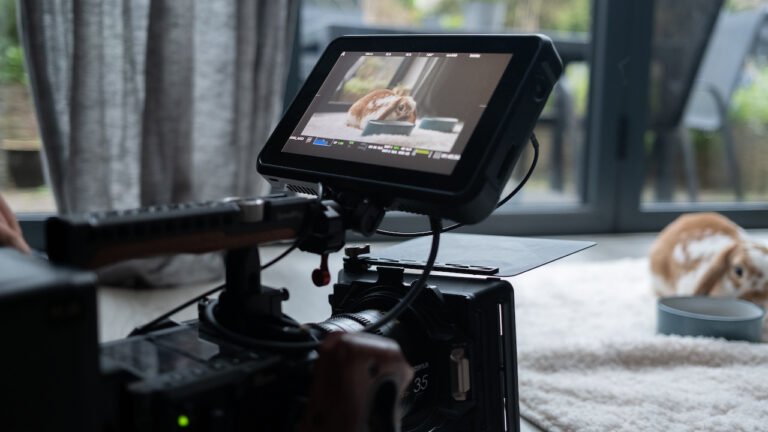To make video content a cornerstone of your marketing strategy, start by understanding who your audience is and what they want. You can’t just create any video; it needs to resonate with your audience’s interests and behaviors. Once you’ve got that figured out, the next step involves selecting the right platforms. Where does your audience spend their time online? Each platform has its own strengths, so your content should be tailored accordingly. But that’s just scratching the surface—let’s explore how you can develop engaging content that not only captures attention but also drives action.
Key Takeaways
- Understand your audience’s demographics, interests, and pain points to tailor video content effectively.
- Choose the right platforms by analyzing where your audience spends time online.
- Develop engaging content with strong hooks, quality production, and emotional storytelling.
- Optimize videos for SEO with keyword-rich titles, descriptions, and captivating thumbnails.
- Measure success through KPIs like views, watch time, and engagement metrics to refine strategy.
Understand Your Audience
Understanding your audience is the essential first step in crafting a video content marketing strategy that truly resonates and drives engagement. You need to dive deep into who your audience is—demographics, interests, pain points, and behaviors. Start by creating detailed buyer personas. These personas should represent your ideal customers and guide your content creation process.
Next, gather data from your existing customers and social media insights. Pay attention to the type of content they interact with most. Are they more engaged with tutorials, behind-the-scenes looks, or customer testimonials? Knowing their preferences will help you tailor your videos to meet their needs and interests.
Engage directly with your audience through surveys and polls. Ask them what kind of content they’d like to see. This not only makes them feel valued but also provides you with invaluable insights.
Analyzing comments and feedback on your current content can also reveal what’s working and what’s not.
Choose the Right Platforms
Selecting the right platforms for your video content is essential to ensuring your message reaches and engages your target audience effectively. Different platforms cater to varied audiences and offer unique features that can enhance your content’s impact.
Start by analyzing where your audience spends their time online. For instance, if your target demographic is young and trendy, TikTok or Instagram might be your best bet. On the other hand, if you’re aiming for a more professional crowd, LinkedIn is a solid choice.
Consider the strengths and weaknesses of each platform. YouTube is fantastic for long-form content and SEO, while Facebook excels in community engagement and sharing. Instagram Stories offer a more ephemeral, behind-the-scenes look, perfect for building a personal connection with your audience.
Don’t forget about emerging platforms either; they often present less competition and can help you stand out.
Cross-platform consistency is also key. While you should tailor content to each platform’s strengths, maintaining a consistent brand voice and visual style helps build trust and recognition.
Develop Engaging Vidoe Content
To capture your audience’s attention and keep them engaged, focus on creating content that resonates on an emotional and intellectual level. Start by understanding your target audience’s interests, pain points, and aspirations. Conduct surveys, read customer reviews, and engage with your audience on social media to gather insights.
Once you’ve identified what matters to them, craft stories that reflect those themes. Use storytelling techniques to evoke emotions—whether it’s humor, empathy, or inspiration. Remember, people are more likely to share content that makes them feel something.
Keep your videos concise. Attention spans are short, so get to the point quickly. Use a strong hook in the first few seconds to grab attention. Think about the value you’re providing: are you educating, entertaining, or solving a problem? Each piece of content should serve a purpose.
Visuals matter. Invest in quality production to make your videos visually appealing. Use compelling visuals and dynamic editing to keep viewers engaged.
Optimize Your Video Content for SEO
Boost your video content’s visibility by mastering SEO techniques that guarantee your content reaches your target audience. Start by conducting thorough keyword research. Use tools like Google Keyword Planner or SEMrush to identify terms your audience is searching for. Incorporate these keywords naturally into your video titles, descriptions, and tags.
Next, craft compelling video titles that aren’t only keyword-rich but also engaging. Your title should pique curiosity and promise value. Follow this with detailed descriptions. A well-written description, around 200-300 words, should provide context and include relevant keywords without keyword stuffing. This helps search engines understand your content better.
Don’t forget about transcriptions and captions. Providing a transcript of your video boosts your SEO by making your content accessible and easier for search engines to index. Captions not only improve accessibility but also keep viewers engaged, which can positively impact your rankings.
Also, focus on your video’s thumbnail. A captivating, high-quality thumbnail can significantly boost your click-through rate.
Lastly, promote your video through social media, blogs, and other platforms to generate backlinks, enhancing your video’s authority and search engine ranking.
Measure the Success of Your Video Content
After optimizing your video for SEO, it’s important to measure your success to understand what’s working and make data-driven decisions for future content. Start by tracking key performance indicators (KPIs) like views, watch time, and audience retention. These metrics give you a clear picture of how engaging your content is.
Use analytics tools like Google Analytics, YouTube Analytics, or social media insights to dive deeper. Look at traffic sources to see where your audience is coming from and which platforms are most effective. Pay attention to engagement metrics such as likes, shares, and comments, as these indicate how well your content resonates with viewers.
Don’t overlook conversion metrics. Measure how many viewers take desired actions, like signing up for newsletters or making purchases, after watching your video. This helps you gauge the direct impact of your video content on your business goals.
It’s essential to regularly review these metrics to spot trends and identify areas for improvement. Adjust your strategy based on what you learn. By consistently measuring your success, you can refine your approach, create more impactful videos, and ultimately, strengthen your content marketing strategy.
Frequently Asked Questions
What Equipment Do I Need to Start Creating Quality Video Content?
You’ll need a good camera, external microphone, tripod, and proper lighting. Don’t forget about editing software to polish your videos. Investing in these essentials guarantees your content looks professional and engages your audience effectively.
How Often Should I Post Video Content?
You should post video content consistently, ideally once a week. This keeps your audience engaged and builds anticipation. Analyze your audience’s behavior and adjust frequency based on engagement metrics to optimize your strategy further.
Can I Repurpose Existing Content Into Video Format?
Certainly, you can repurpose existing content into video format. It’s a strategic way to maximize your resources, engage your audience visually, and breathe new life into your content. Just make sure it’s compelling and tailored to your audience.
How Do I Budget for Video Content Production?
Imagine your budget as a puzzle; prioritize essential pieces like equipment, editing software, and talent. Start small, track ROI, and adjust accordingly. Don’t forget to allocate funds for unforeseen expenses. It’s all about strategic planning and flexibility.
What Are Some Effective Ways to Promote My Video Content?
You should share your videos across social media platforms, collaborate with influencers, and optimize for SEO. Engage your audience through compelling thumbnails and titles, and don’t forget to use email marketing to boost viewership.
Conclusion
Incorporating video into your content marketing strategy can skyrocket your engagement and conversions.
Did you know that 88% of marketers say video marketing provides them with a positive ROI?
By understanding your audience, choosing the right platforms, creating engaging content, optimizing for SEO, and measuring success, you’ll harness video’s full potential.
Don’t wait—start leveraging video today and watch your marketing efforts transform from good to extraordinary. Get in touch with Gray Media to see how we can help you achieve your goals through video content marketing!






